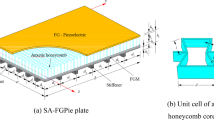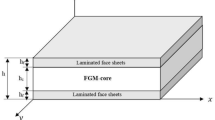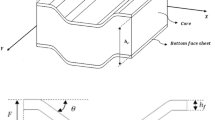Abstract
Background
The quasi-3D finite element model includes the smart actuation on a three-layer sandwich plate with laminated composite face-sheets. In the model, the face-sheets are represented as Reissner-Mindlin plates and the core is modeled as a three-dimensional continuum.
Purpose
This representation allows accurate modeling for a wide range of core types. In this model, the electrical constitutive relations of piezoelectric layers are included in the formulation of the face-sheets. In previous publications, this quasi-3D finite element formulation has demonstrated some advantages in comparison with solid finite element models. The aspect ratio of three-dimensional elements can make it rather inconvenient to use on very thin faces-sheets, which makes the number of degrees of freedom very high.
Methods
Analytical through-thickness integration of the energy expressions is used to reduce the three-dimensional problem to two dimensions for the evaluation of mass and stiffness matrices. In the same way, the analytical integration of the electrical voltages work applied to the piezoelectric layers produces the piezoelectric actuation force vector.
Result
This research assesses the accuracy of the proposed model for dynamic responses of sandwich plates using a broad range of core-to-face-sheet stiffness ratio.
Conclusions
The numerical results show that deflections promoted by the voltage applied to piezoelectric layers of the sandwich plate are very small, even if the core is very flexible. The results also indicate that the core flexibility strongly affects the natural frequencies of the higher bending modes.











Similar content being viewed by others
References
Oskooei S, Hansen JS (2000) Higher-order finite element for sandwich plates. AIAA J 38(3):525–533. https://doi.org/10.2514/2.991
Nabarrete A, Almeida SFM, Hansen JS (2003) Sandwich-plate vibration analysis: three-layer quasi-three-dimensional finite element model. AIAA J 41(8):1547–1555. https://doi.org/10.2514/2.2106
Frostig Y, Baruch M, Vilnay O (1992) A high order theory for the bending of sandwich beams with a flexible core. J Eng Mech 118(5):1026–1043. https://doi.org/10.1061/(ASCE)0733-9399(1992)118:5(1026)
Thomsen OT (1993) Analysis of local bending effects in sandwich plates with orthotropic face layers subjected to localized loads. Compos Struct 25(1):511–520. https://doi.org/10.1016/0263-8223(93)90199-Z
Frostig Y, Baruch M (1994) Vibration of sandwich beams—a high order theory approach. J Sound Vib 176(2):195–208. https://doi.org/10.1006/jsvi.1994.1368
Frostig Y, Rabinovitch O (2000) Behavior of unidirectional sandwich panels with a multi-skin construction or a multi-layered core layout-high-order approach. J Sandw Struct Mater 2(3):181–213. https://doi.org/10.1177/109963620000200302
Di Sciuva M, Icardi U (2000) On modeling of global and local response of sandwich plates with laminated faces. J Sandw Struct Mater 2(4):350–378. https://doi.org/10.1106/1PXX-A8XG-295R-XJV9
Schwarts-Givli H, Rabinovitch O, Frostig Y (2008) Free vibration of delaminated unidirectional sandwich panels with a transversely flexible core and general boundary conditions—a high-order approach. J Sandw Struct Mater 10(2):99–131. https://doi.org/10.1177/1099636207076484
Alijani F, Amabili M (2013) Nonlinear vibrations of laminated and sandwich rectangular plates with free edges. Part 1: theory and numerical simulations. Compos Struct 105:422–436. https://doi.org/10.1016/j.compstruct.2013.05.034
Rechdaoui MS, Azrar L (2010) Active control of secondary resonances piezoelectric sandwich beams. Appl Math Comput 216:3283–3302. https://doi.org/10.1016/j.amc.2010.04.055
Crawley EF, De Luis J (1987) Use of piezoelectric actuators as elements of intelligent structures. AIAA J 25(10):1373–1385. https://doi.org/10.2514/3.9792
Bailey T, Hubbard JE Jr (1985) Distributed piezoelectric-polymer active vibration control of a cantilever beam. J Guid Control Dyn 8(5):605–611. https://doi.org/10.2514/3.20029
Batra RC, Liang XQ, Yang JS (1996) Shape control of vibrating simply supported rectangular plates. AIAA J 34(1):116–122. https://doi.org/10.2514/3.13030
Ghosh K, Batra RC (1995) Shape control of plates using piezoceramic elements. AIAA J 33(7):1354–1357. https://doi.org/10.2514/3.12427
Sonti VR, Jones JD (1996) Dynamic effects of piezoactuators on the cylindrical shell response. AIAA J 34(4):795–801. https://doi.org/10.2514/3.13142
Tzou HS, Ye R (1996) Analysis of piezoelastic structures with laminated piezoelectric triangle shell elements. AIAA J 34(1):110–115. https://doi.org/10.2514/3.12907
Chandra R, Chopra I (1993) Structural modeling of composite beams with induced-strain actuators. AIAA J 31(9):1692–1701. https://doi.org/10.2514/3.11832
Hernandes JA, Almeida SFM, Nabarrete A (2000) Stiffening effects on the free vibration behavior of composite plates with PZT actuators. Compos Struct 49(1):55–63. https://doi.org/10.1016/S0263-8223(99)00125-7
Avdiaj S, Setina J, Syla N (2009) Modeling of the piezoelectric effect using the finite-element method (FEM). Mater Technol 43(6):283–291 ISSN 1580-2949
Ferrari G, Amabili M (2015) Active vibration control of a sandwich plate by non-collocated positive position feedback. J Sound Vib 342:44–56. https://doi.org/10.1016/j.jsv.2014.12.019
Sodano HA, Park G, Inman DJ (2004) An investigation into the performance of macro-fiber composites for sensing and structural vibration applications. Mech Syst Signal Process 18(3):683–697. https://doi.org/10.1016/S0888-3270(03)00081-5
Heppler GR, Hansen JS (1986) A mindlin element for thick and deep shells. Comput Methods Appl Mech Eng 54(1):21–47. https://doi.org/10.1016/0045-7825(86)90033-2
IEEE Standard on Piezoelectricity, in ANSI/IEEE Std 176-1987, (1988) 1–66 https://doi.org/10.1109/IEEESTD.1988.79638.
de Abreu GLCM, Ribeiro JF, Steffen V Jr (2004) Finite element modeling of a plate with localized piezoelectric sensors and actuators. J Braz Soc Mech Sci Eng 26(2):117–128. https://doi.org/10.1590/S1678-58782004000200002
Piefort V, Preumont A (2000) Modeling of smart piezoelectric shell structures with finite elements. ISMA25 International Conference on Noise and Vibration Engineering, Katholieke Universiteit Leuven, Belgium, https://doi.org/10.2514/2.21063
Author information
Authors and Affiliations
Corresponding author
Ethics declarations
Conflict of interest
The authors declare that they have no conflict of interest.
Funding
This study has no funding agency.
Additional information
Publisher's Note
Springer Nature remains neutral with regard to jurisdictional claims in published maps and institutional affiliations.
Rights and permissions
About this article
Cite this article
Nabarrete, A. A Three-Layer Quasi-3D Finite Element Analysis for Smart Actuation on Sandwich Plates. J. Vib. Eng. Technol. 11, 391–401 (2023). https://doi.org/10.1007/s42417-020-00260-z
Received:
Revised:
Accepted:
Published:
Issue Date:
DOI: https://doi.org/10.1007/s42417-020-00260-z




